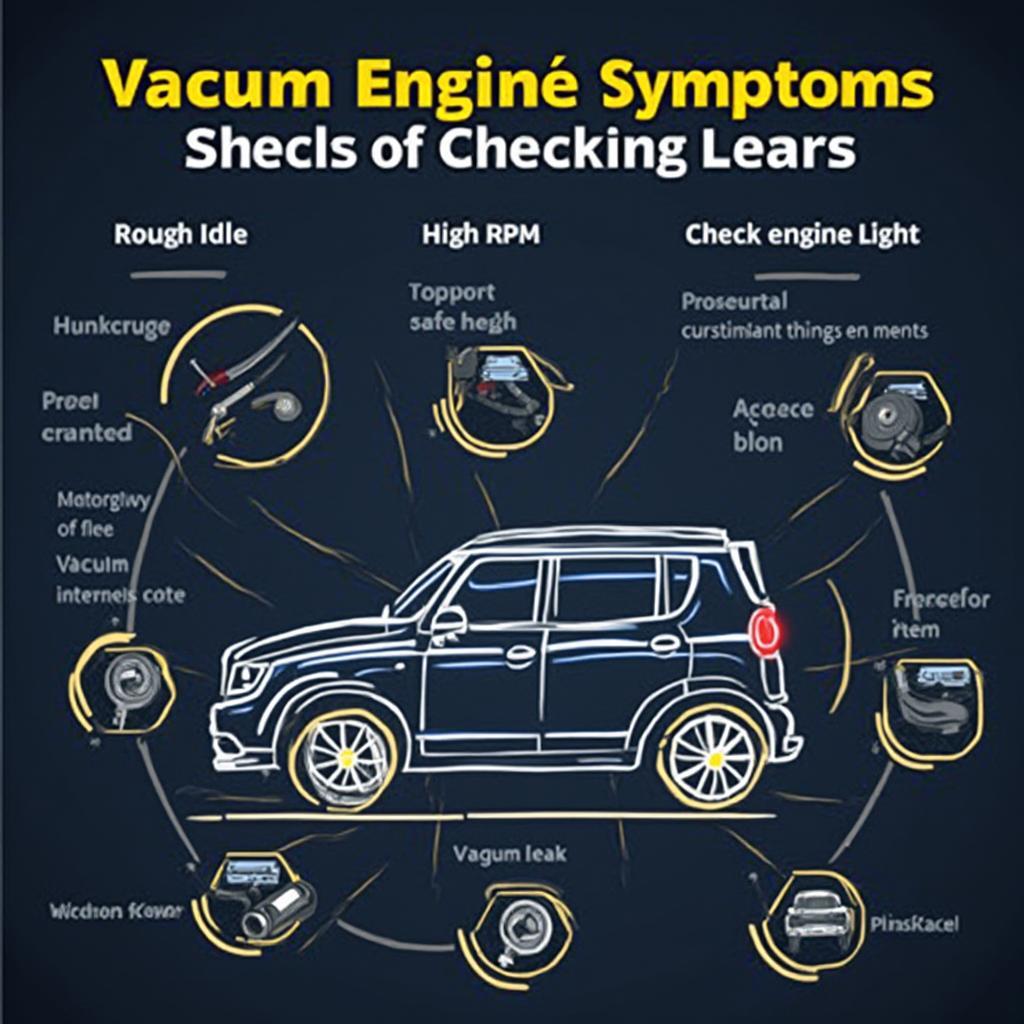Vacuum leaks are a common cause of engine performance issues, often triggering specific OBD2 codes. Understanding these vacuum leak codes OBD2 is crucial for diagnosing and fixing these problems, ensuring your vehicle runs smoothly. This article will delve into the intricacies of vacuum leaks, their associated OBD2 codes, and how to address them.
A vacuum leak disrupts the carefully balanced air-fuel mixture your engine needs for optimal performance. This disruption can lead to a variety of problems, from rough idling to reduced fuel efficiency. Identifying the specific OBD2 code related to a vacuum leak is the first step towards resolving the issue.
What are Vacuum Leak Codes OBD2?
Vacuum leak codes OBD2 are diagnostic trouble codes (DTCs) that pinpoint issues related to the engine’s vacuum system. These codes are generated when the onboard computer detects inconsistencies in the air-fuel mixture or other parameters related to vacuum pressure. Common vacuum leak codes include P0171, P0174, and P0106, though other codes can also indicate a vacuum leak. Understanding these codes allows you to quickly identify the likely source of the problem. For example, a P0171 code often indicates a lean air-fuel mixture, a common symptom of a vacuum leak. obd2 p0133 code can also sometimes be related to vacuum leaks, although it primarily refers to a slow response from an oxygen sensor.
Common Symptoms of a Vacuum Leak
Recognizing the symptoms of a vacuum leak is vital even before plugging in your OBD2 scanner. Common signs include:
- Rough idle: The engine may shake or vibrate excessively at idle.
- Increased idle speed: The engine may rev higher than normal at idle.
- Hissing sound: A noticeable hissing sound from the engine bay can indicate a vacuum leak.
- Reduced fuel economy: A vacuum leak can cause the engine to burn more fuel.
- Check engine light: The check engine light will illuminate when a vacuum leak triggers an OBD2 code.
Diagnosing Vacuum Leak Codes OBD2
Once you’ve identified a potential vacuum leak through symptoms or OBD2 codes, you can begin the diagnostic process. Several methods can be employed:
- Visual inspection: Carefully inspect vacuum hoses, connections, and the intake manifold for cracks, breaks, or loose fittings.
- Smoke test: A smoke test introduces smoke into the intake system to pinpoint the location of a leak.
- Propane test: Carefully introducing propane around potential leak areas while monitoring engine RPM can help locate the source.
- Carburetor cleaner test: Similar to the propane test, spraying carburetor cleaner around suspected areas can identify leaks.
Tools for Diagnosing Vacuum Leaks
Having the right tools can greatly simplify the process. These include:
- OBD2 scanner: Essential for reading and interpreting the diagnostic trouble codes.
- Smoke machine: Used for performing smoke tests.
- Propane torch: Used with caution for propane tests.
- Carburetor cleaner: A helpful tool for pinpointing leaks.
- Vacuum gauge: Useful for measuring vacuum pressure and identifying fluctuations.
Fixing Vacuum Leaks
Once the leak is located, the fix is usually straightforward. This may involve:
- Replacing damaged vacuum hoses: Hoses become brittle with age and can crack or break.
- Tightening loose connections: Ensure all vacuum hose connections are secure.
- Replacing gaskets: Damaged intake manifold gaskets are a common cause of leaks.
If you encounter obd2 code p1521, it might indicate a vacuum leak affecting the variable valve timing system. Similarly, certain obd2 codes for 2000 ford mazda pickups could be indicative of vacuum leaks. It’s essential to consult your vehicle’s specific repair manual for detailed instructions and appropriate procedures. You can also learn more about specific car models, such as obd2 nissan qashqai 2014, or specific code issues, like the chevy impala obd2 code p0138, on dedicated websites.
Conclusion
Understanding vacuum leak codes OBD2 is essential for maintaining your vehicle’s performance and fuel efficiency. By recognizing the symptoms, using the right diagnostic tools, and implementing the necessary repairs, you can ensure your engine runs smoothly and efficiently. Addressing these issues promptly prevents further damage and keeps your vehicle operating at its best.
Need help? Contact us via WhatsApp: +1(641)206-8880, Email: [email protected] or visit us at 789 Elm Street, San Francisco, CA 94102, USA. Our customer service team is available 24/7.


